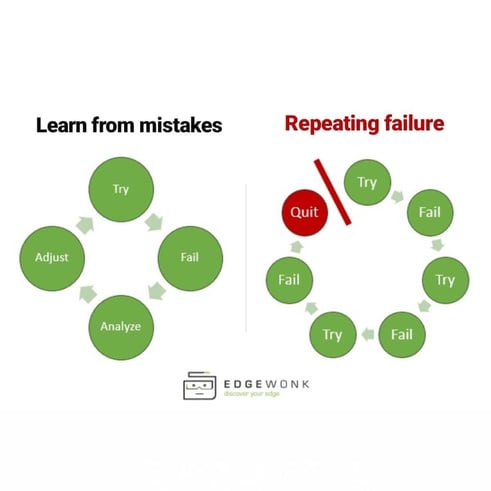3 min read
Scientist Discovered Why Most Traders Lose Money – 24 Surprising Statistics
“95% of all traders fail” is the most commonly used trading related statistic around the internet. But no research paper exists that proves this...
5 min read
Rolf
Mar 24, 2019 8:00:00 PM

It does not matter whether you are reading sophisticated trading books or just browse around online trading forums, almost every trader seems to be aware of the fact that psychology has a big impact on trading performance.
Most traders just talk about fear and greed, but emotions go much deeper than that in trading. At the same time, it is not practical to stop at fear and greed. We need to identify the situations in which emotions take over and then develop action plans to conquer the emotional responses.
The goal is that we become so self-aware that, at the moment the emotions are about to take over, we can identify this exact moment and counter our response. In the beginning, this won’t be possible but the more practice we have, the faster we will recognize that we are becoming emotional and we can avoid further damage sooner and sooner.
For that, we need to understand HOW emotions manifest in our trading. For me, it helped going through past trades (regularly) and to try to understand what caused the loss. I’d often find out that the same triggers and impulses were the root causes. Then, with time, I was able to catch myself sooner and sooner whenever the impulse came up. Of course, every now and then I still slip up, but perfection is not the end goal.

In the following, we take a look at things traders say, think or do and what it means for their emotional impulses.
If you notice that you constantly miss trades, although they meet all your entry criteria, you should decrease your risk. Eliminating the possibility to risk a substantial amount of money will usually help decrease the impact of fear-based trading errors.
Then, it is about building confidence in yourself and in your trading strategy. Journaling and backtesting are great activities here. After you have gained confidence and trust your trading strategy you can slowly increase trade size until you find your threshold.
Printing out your trading rules and checking them off one by one can also help with eliminating the fear of entering trades.
Traders with small trading accounts will often risk too much on a single trade. Often, such traders don’t even have rules for their position sizing, to begin with. But also traders in a winning streak will often increase their risk and become reckless. Adding to a losing trade, trying to avert the loss is also a big issue.
What is it for you? If you experience disproportionally large losses, you need to take a close look at your risk management. In professional trading, no single trade should stand out.
The best thing you can do is to reduce trade size and also to establish a default position size to avoid large drawdowns and account swings. You should set an absolute maximum risk level that you will not cross – no matter how good you think a setup is.
This sentence is a continuation of the previous case. When traders believe that a setup is too good to fail, they are more likely to find reasons to avoid realizing losses by widening stop loss orders, adding to losers or completely taking off stops.
“Too good to fail” is a belief that manifests because traders are inexperienced, trade too much size or just do not understand the role of losses in trading.
When you find yourself in a similar position, you are trading based on hope and ignorance.
I recommend using trading plans for every trade. In a trading plan you write the reasons for your trade entry and you also define when the time to exit is. This way, you can become more objective and you are more likely to stick to the rules.
A sure sign that greed is influencing your trading decisions is when you do not take profits, even though the price has already reached your take profit level. Although you might be able to get a bigger winner every now and then, what usually happens is that you will constantly give back profits and cut your winners short. Over the long, term this can even turn a good trading system into a losing one.
Always stick to the plan you made before you entered the trade. Don’t listen to the greedy voice in your head that pops up once you are in a trade.
If you really want to find out if you can use a wider profit target, start tracking it in your journal and you will get a definite answer.
This is the opposite scenario. Whereas greedy traders will not realize profits because they hope to get more, fearful traders close trades too soon because they fear that markets can turn any second.
This behavior is usually caused by trading too big when a single tick has a disproportionate impact on the account balance or a lack of confidence.
The set-and-forget approach, where you close your chart after you opened the trade and set stop loss and take profit order might work well for some trading strategies. Don’t watch your P&L during trades because you will start worrying about every down-tick. Gain trust in your trading strategy over time and accept the fact that price moves in waves – retracements are, therefore, normal and should not be mistaken with reversals.
Taking screenshots of every trade is also helpful when you can observe over time how price REALLY behaves. Uncertainty is a big driver of fear.
Entering trades too early because you worry that you could miss a trade is another sign that greed is messing around with you. At the same time, uncertainty and a lack of understanding the strategy can also cause such emotional responses.
Having clearly established trading rules is the best way to go here. The more you can remove uncertainty, the more confidence you can have in your trades and the less likely you are going to mess it up.
If you see that, after you closed your trade, price would have further moved in your favor, you are more likely to set wider take profit orders on the next trade. Setting wider take profit orders, without statistically validating that it will have a positive effect on your trading performance, can be a very dangerous thing to do. Usually, just randomly using wider take profit orders will only result in a lower winrate because price will turn ahead of your take profit order.
Another problem that arises from hindsight knowledge is when traders see that a trade would have worked out even though not all entry criteria had been met, they are more likely to violate trading rules on their next trades.
Hindsight knowledge is a very important thing in trading, especially when it comes to making improvements to your trading strategy and tweaking your edge, but the way traders use hindsight is completely wrong. Here are a few tips how to use hindsight to your advantage:

3 min read
“95% of all traders fail” is the most commonly used trading related statistic around the internet. But no research paper exists that proves this...

3 min read
Trendlines can be great trading tools if used correctly and in this post, I am going to share three powerful trendline strategies with you.

3 min read
Choosing the right trading journal is essential for traders wanting to analyze performance, refine strategies, and improve consistency. In this...